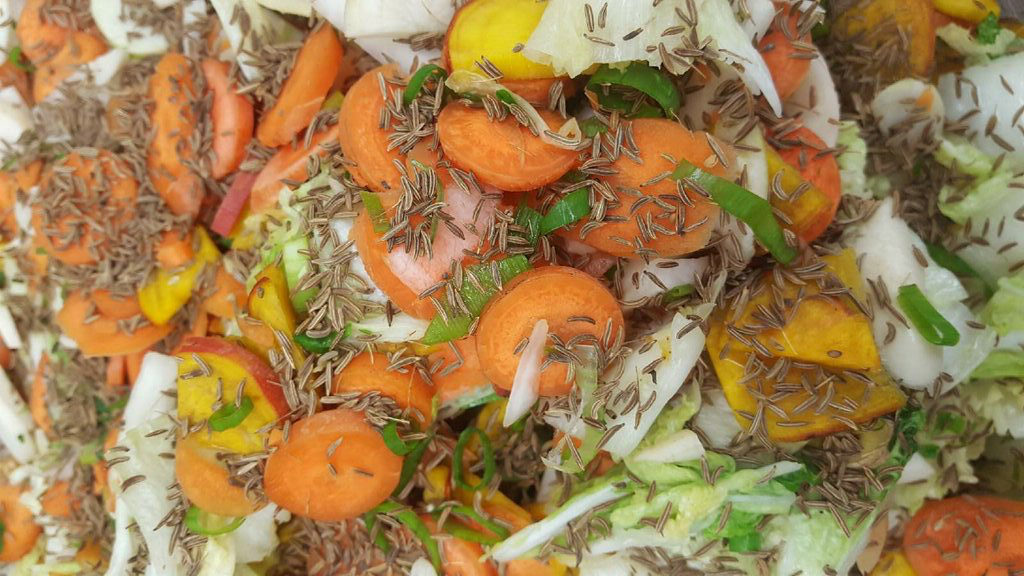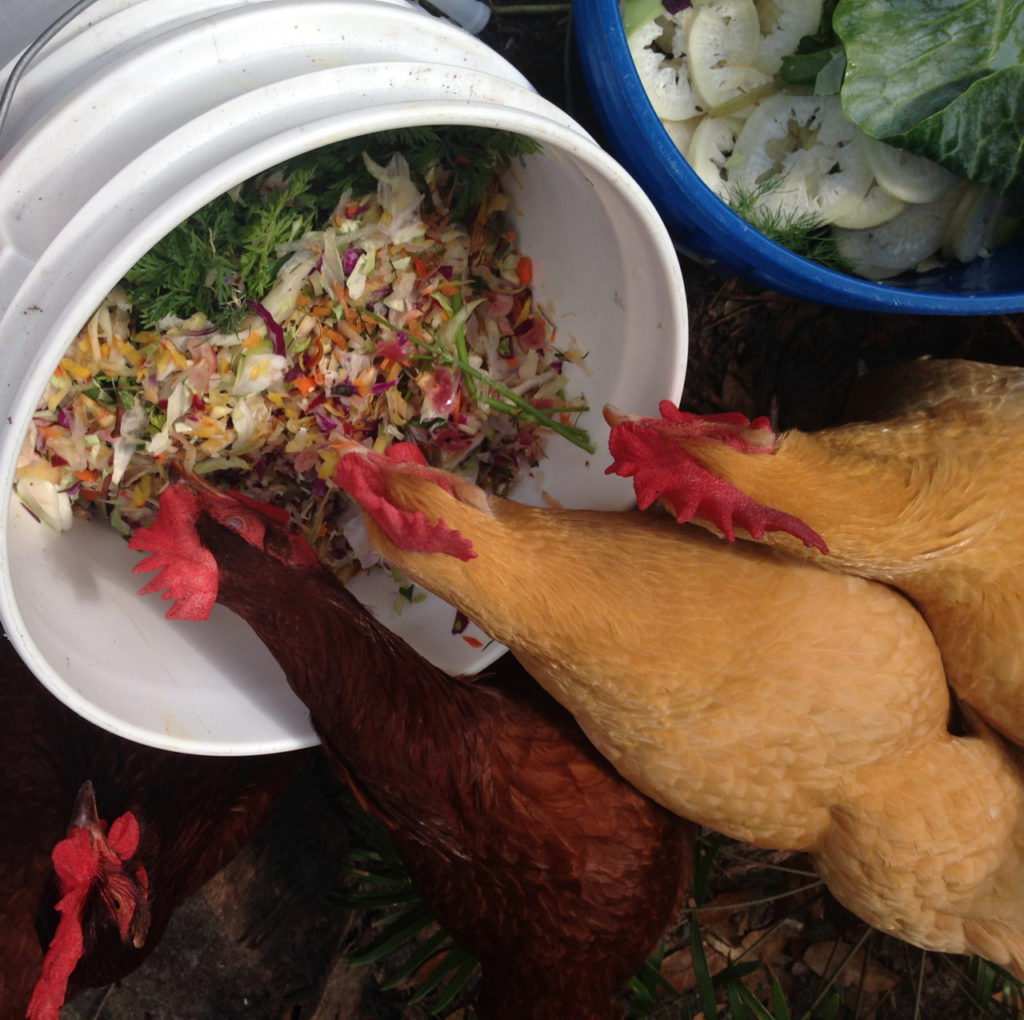Written by Melissa DeSa
This is the time of year to gather up that winter veg that’s in season from local farms, and stuff it into a crock or jar with some salt and herbs. Cabbage, radishes, carrots, beets are all in season. Ginger and turmeric dug in the fall is still fresh and waiting to season your ferments. We used to teach a class every winter with the “Queens of Fermentation”: Mary Santello, Karen Sherwood, Susan Marynowski and yours truly, Melissa DeSa. We haven’t lately because it seems the culture has spread, as intended! We still get asked for recipes and tips, so here you go! We’re sharing with you some of our favorites. You can download the PDF here.
 Why are we so crazy about ferments? Because they are alive! Billions of beneficial microorganisms, including Lactobacillus acidophilus combine forces to restore and maintain a vibrant ecosystem of intestinal flora. When enjoyed on a regular basis, this probiotic food will energize the digestive system to increase nutrient absorption and eliminate toxins, resulting in overall superior immune system function.
Why are we so crazy about ferments? Because they are alive! Billions of beneficial microorganisms, including Lactobacillus acidophilus combine forces to restore and maintain a vibrant ecosystem of intestinal flora. When enjoyed on a regular basis, this probiotic food will energize the digestive system to increase nutrient absorption and eliminate toxins, resulting in overall superior immune system function.
Inspiration from The Cultured Pickle
- Watermelon Rind Kim Chee
- Celery, Sunchoke, & Radish with Coriander & Jalapeno
- Butternut Squash & Maitake Mushroom Kim Chee
- Beets & Daikon with Arame, Ginger, & Peppercorns
- Green Tomato Kim Chee
- Celery with Spring Onions, Dulse, & Matcha
- Japanese Cucumber & Arame Kim Chee
- Tokyo Turnips with Matcha & Maitake
- Beets with Fennel
- Celery & Fennel with Wheatgrass & Mint
- Armenian Cucumbers, Red Onion, Red Jalapeno, Green Coriander
- Kohlrobi & Leek with Dill & Juniper
- Spicy Purple Carrots with Oregan
- Red Daikon with Turmeric, Cardamom, & Fenugreek
As you can see the sky’s the limit! You can also do hot sauce, tomato paste, and many other ethnic, regional, and cultural delights.
Basic Equipment
- vegetable chopper: knife, box grater, mandolin slicer or a food processor
- cutting board
- pounding tools: blunt meat pounder or potato masher to pound juices out of the vegetables
- large container to hold vegetables for pounding
- salt: Celtic salt, sea salt, real salt
- pure water (NOT chlorinated tap water)
- fermenting vessel such as a crock or glass jar and a weight and cover system
- fresh veggies and fresh or dried herbs and spices
Vegetables To Ferment
Cabbages, carrots, beets, cucumbers, onions, garlic, ginger, daikon and other radishes, horseradish, turnips, rutabagas, celery, kohlrabi, leeks, okra, beans, fennel, peppers, squash, green tomatoes, watermelon rind and probably many more!
Herbs and Spices
Caraway seeds, dill weed and seeds, juniper berries, grape leaves, oak leaves, fennel leaves and seeds, parsley, cumin, cilantro, mustard seeds, celery seeds, cardamom, coriander seeds, cloves, pepper flakes, bay leaves, raspberry leaves, tarragon.
General Instructions
- Lightly rinse your vegetables (if at all) in filtered water.
- Prepare a brine solution of 1-2 tbsp salt/quart water, to pour over your tightly packed veggies and spices.
- Chop or grate veggies, in consistent sizes for even fermentation.
- Place the veggies and herbs/spices in a big bowl, liberally sprinkle with salt.
- Massage veggies if shredded to release the juices; or mix briefly if chunks.
- Add to fermenting vessel, packing as tight as possible.
- Pour brine over veggies so they are completely submerged.
- Weigh down veggies so they are under the brine
- Loosely cover with a lid and/or towel to allow gas exchange and to keep out dust and flies
- Store in a cool place, tasting every day until you like it, then transfer to refrigerator for longer term storage.
Folks are always concerned about the safety. This isn’t like canning and and a ferment that’s gone off is easy to sniff! Also it won’t kill you. But as you create them just remember our motto: “If it’s under the brine, it’s fine!” Check daily, stuff floating veggies underneath the brine, add more brine if needed, and weigh it down with weights or ziploc baggies filled with water.
Recommended Books
Check out your local bookstore and support them first! Here we love Third House Books.
- Wild Fermentation by Sandor Elix Katz
- Nourishing Traditions by Sally Fallon with Mary Enig
- Making Sauerkraut and Pickled Vegetables at Home by Klaus Kaufmann and Annelies Schoneck
RECIPES
Beet Kvass
from Sally Fallon, Nourishing Traditions
- 3 medium or 2 large organic beets, peeled and chopped up coarsely
- 1 Tbsp sea salt
- Filtered water
Place beets and salt in a 2-quart glass container. Add filtered water to fill the container. Stir well and cover securely. Keep at room temp 2-5 days before transferring to fridge.
Note: Do not use grated beets for this recipe. When grated, beets exude too much juice resulting in a too rapid fermentation that favors alcohol production rather than lactic acid.
Beets are exceptionally nutrient-dense and as a fermented beverage, are valuable for their medicinal qualities as well as being a digestive aid. According to Sally Fallon in Nourishing Traditions, one 4-ounce glass, morning and night, is an excellent blood tonic, promotes regularity, aids digestion, alkalizes the blood, cleanses the liver and is a good treatment for kidney stones. Kvass may also be used in place of vinegar in salad dressings and as an addition to soups.
Sauerruben (“Sour Roots”)
from Susan Marynowski
- 4 medium-large golden beets
- 4 medium-large carrots
- 2 small-medium rutabaga
- 1 large parsnip
- 1 small cabbage
- sea salt
- 4-6 Cloves garlic, pressed
- 2 Tbsp celery seed
- 2 Tbsp caraway seed
- 1 Tbsp dill weed, dried
- 1 Tbsp cumin seed powder
Shred or julienne the roots and thinly slice the cabbage so that they have a fine and consistent texture. Salt everything liberally with sea salt as you go. Mix and squeeze everything well with hands. Pack firmly into jar or crock. Add some brine (salted water) if necessary. Allow to ferment one week, more or less, to taste. This recipe makes about a gallon of sauerruben. Cut the recipe in half to make 1/2-gallon or 2 quarts.
Note: Great to substitute locally available daikon radish, black Spanish radish, and/or turnip in the blend, instead of cabbage. Turnips and radishes (especially daikon) will make the blend more moist so you don’t have to add brine. EVERYTHING is negotiable. Garlic and spices are all optional and open to adjustment. If you prefer a coarser or chunkier texture, cut your root vegetables in that manner. You may want to keep things about the same size so that fermentation is even, but even that rule can be broken!
Seminole Kimchee
from Mary Santello
Makes about 2 quarts
First prepare a fennel infused brine:
- 2 cups water
- 2 Tbsp sea salt
- feathery tops of fennel
- Bring water to boil, add salt and fennel tops. Take off heat and let steep till cool. Meanwhile, prep the kimchee:
- 8 cups peeled and diced winter squash
- 4 cups sliced fennel bulb
- 2 cups sliced daikon radish
- 1 small-medium sized red onion
- 3-4 minced garlic cloves
- 1-2″ piece of peeled and grated ginger
- fresh sliced chilies, or dry red chili flakes to taste
Try to make all veg relatively uniform in thickness and size. Using a food processor is handy for this but not necessary. Toss all ingredients in a large bowl to mix. Pack into quart-sized jars leaving about 1″ head space. When brine is cool pour into jars to cover the veg. Press veg down to submerge it under the brine. Cap the jar, but leave lid loose to allow brine to seep. Place jars in a dish to catch seepage and leave in a cool, dark spot for 4-5 days. Check it 1-2 times a day, each time pressing veg back down under the brine. You may alternately weight veg down with a small glass. After about 4 days give the veg a taste, and when it is sour to your taste, refrigerate. The ferment will continue to age and improve in flavor for several months.
Classic Kraut
By Mary Santello
- Cabbage (white, savoy, or red will do)
- Caraway seed
- Sea salt
- Cabbage, thinly sliced
Mix cabbage with salt (1-2 tsp per 4 cups veg) to taste, adding caraway seed. Cover and let sweat 15 minutes. Pack into clean jars, pressing down to get the brine to rise. Seal, let sit in a cool place 3-7 days, refrigerated.
Kimchee
By Mary Santello
- Napa Cabbage , sliced in 1” lengths
- Carrots, thinly sliced
- Daikon radish, thinly sliced
- Scallions, sliced in 1” lengths
- Ginger, grated
- Garlic, pressed
- Chili pepper (fresh or dried flakes)
- Sea salt
Mix all veggies in a bowl, mashing with hands, and adding chili to taste. Add sea salt (1-2 tsp to each 4 cups veg), or to taste. Mix again. Cover and let sweat 15 minutes. Pack into clean jars, pressing down to get the brine to rise. Seal, let sit in a cool place 3-7 days, then jar up and refrigerate.
Pickled Carrots
By Mary Santello
- Carrots, thinly sliced
- Ginger, grated
- Lemon grass stalks, sliced
- Cilantro, finely chopped
- Chili pepper (fresh or dried flakes)
- Sea salt
- Water
Mix all veggies and herbs in a bowl, mashing with hands, adding chili to taste. Add sea salt, (1-2 tsp to each 4 cup veg), or to taste. Cover and let sweat for 15 minutes. Pack into clean jar. There will not be a lot of liquid, so add a bit of purified water to submerge the veg. Seal and leave sit in a cool place 3-7 days, refrigerated.
Burmese/Cambodian Fermented Mustard Pickles
By Mary Santello
Makes 1 pint
- Brine water: 1 Tbsp sea salt to 4 C water
- 2 carrots, sliced thin diagonally, about 3 cups
- 1/2 lb shallots, peeled, or use red onion and just a pinch of pressed garlic
- 2 tsp dried red hot chili flakes (I used Korean hot pepper flakes) or to taste
- 2 tsp salt
- 2 tsp brown sugar
- 1/2 tsp ground turmeric
- 1 cup beer
Rinse the mustard leaves in water, leaf by leaf, to remove any sand. Chop or slice into strips. Sauté/ steam quickly to wilt them with only the water that is on the leaves. Mix all ingredients together in a bowl. Squeeze and press the vegetables together in a kneading motion for 10 minutes. This will integrate the flavorings with the vegetables. Cover the bowl and let the pickle ferment in a warm place or at room temp for 3 days, then pack in covered jars. The pickle may be kept refrigerated for a month or more.
Fermented Yum Hot Sauce
By Mary Santello
You can make your sauce as mild or scorching as you like, red, green or both! You can add sweet peppers to balance the hot as well, it’s really up to your tastes.
Wash well an assortment of your favorite hot peppers, slice stem tops off and remove any rotting spots.
Cut peppers in half and inspect the seeds. If they are black at all, remove them and wash the split pepper again! You can leave fresh white seeds in or remove them and the white tissue if you want to lessen the heat. As the ferment ages, the heat factor will mellow out a bit.
Place prepared peppers in a processor with a bit of water and salt and blend till uniform.
Place sauce in a fermentation jar, test for saltiness and add more if needed, it should be fairly salty. Cap loosely and place in a catch pan.
Ferment for 3-7 days in a cool, dark spot. Check and stir daily! If any mold begins to form on top you can carefully scoop it off, cleaning your spoon after each pass to minimize contamination. Mold does not mean you sauce is bad. As long as it is confined to the top layer, removing it works.
When your sauce has acquired a good tartness, finish it by placing it in a blender and adding 1 Tbs. white vinegar and 1/2tsp, of the least refined sugar you have to every 4 cups of sauce. Blend well, jar up, cap tightly and refrigerate. Your sauces will develop and perfect for a long time, even beyond a year!
FAQ
1. Can I ferment greens?
Although our answer is usually “Sure, why not, you can ferment nearly everything!”, it doesn’t really apply to some winter greens. Kale, collards and broccoli don’t hold their texture well and may produce very strong- smelling ferments. You can add some to a mixture of traditionally fermented veggies but don’t plan on using a lot.
2. Is it OK to buy non-organic?
We highly recommend using organic vegetables whenever possible, but understand if you can’t have all organic. There tends to be less pesticide residue, and if grown in good soil will ferment better. Fresh, local veggies also tend to ferment better and are not as dried out as grocery store veggies. Get to the farmers market and you’ll have plenty of options for the freshest organic produce around!
3. What kind of salt?
No refined salt, only good quality sea salt, coarseness does not matter. We’re very liberal with salt in fermenting, you’ll need plenty.
4. Should I wash my veggies?
Clean but not scrubbed, because while you don’t want outright dirty veggies like carrots straight from the earth, the naturally occurring organisms on the veggies actually help with the fermentation process. The white bloomy appearance on cabbage is GOOD, leave it alone.
5. Are regular mouth sized jars OK and do I need tight lids?
Wide mouth is best but regular is OK. Once the ferments are done and you refrigerate them, it’s good to have a proper fitting lid. Plastic lids are best, the metal rings get rusty with the salt exposure.
6. Should I sanitize my jars?
Not necessary, just make sure they are clean.
That’s it! Of course when you are done, there are loads of vegetable scraps to compost! If you don’t have a home compost system, check out Beaten Path Compost and get on their pick up circuit to curb your waste into soil magic! Or you can toss to your back yard chickens like I do! They love fermentation day. Oh, and this is always better with company. Many hands make light work, and many jars of ferments. If you need a cute cover for your ferments to keep the dust and flies out, check out our multi-use flour sac towels.








